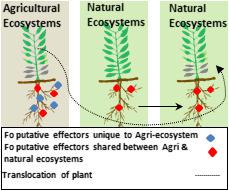当前位置:
X-MOL 学术
›
Plant Pathol.
›
论文详情
Our official English website, www.x-mol.net, welcomes your
feedback! (Note: you will need to create a separate account there.)
Investigating the effector suite profile of Australian Fusarium oxysporum isolates from agricultural and natural ecosystems
Plant Pathology ( IF 2.3 ) Pub Date : 2020-10-24 , DOI: 10.1111/ppa.13303 Saidi R. Achari 1, 2 , Jatinder K. Kaur 1 , Ross C. Mann 1 , Tim Sawbridge 1, 2 , Brett A. Summerell 3 , Jacqueline Edwards 1, 2
Plant Pathology ( IF 2.3 ) Pub Date : 2020-10-24 , DOI: 10.1111/ppa.13303 Saidi R. Achari 1, 2 , Jatinder K. Kaur 1 , Ross C. Mann 1 , Tim Sawbridge 1, 2 , Brett A. Summerell 3 , Jacqueline Edwards 1, 2
Affiliation

|
Pathogenic and putatively nonpathogenic isolates of Fusarium oxysporum are ubiquitously present in soils. Pathogenic isolates designated as formae speciales are very host specific. The genes that determine host‐specific pathogenicity may be expected to be similar between strains within a forma specialis. Three different pathways were used for mining putative effectors from 85 assembled genome sequences representing isolates from the agricultural and natural ecosystems. A total of 436 putative effectors were identified, of which 115 were present in all the isolates. The presence–absence phylogeny showed some clustering of isolates based on the ecosystems, while some clustered with isolates from different ecosystems. Isolates from the agricultural and natural ecosystems shared 358 putative effectors. Agricultural isolates had 78 unique putative effectors, while isolates from the natural ecosystems had no unique effectors. Isolates from the natural ecosystems had effectors that have previously been confirmed with virulence functions in other filamentous fungi, suggesting that the natural ecosystems may be acting as a reservoir for pathogenic isolates awaiting compatible hosts. They also possessed putative effectors with domains involved in polysaccharide degradation. The putative effectors in the natural ecosystem isolates may be important for both parasitic and ecological fitness. Further analysis of the three characterized ff. sp.—lycopersici, niveum, and pisi—revealed high conservation in the pathogenicity mechanism in F. oxysporum. However, each strain had unique putative effectors, which may be responsible for host specificity.
中文翻译:

研究来自农业和自然生态系统的澳大利亚尖孢镰刀菌分离物的效应子套件概况
在土壤中普遍存在尖孢镰刀菌的病原体和推定为非病原体。被指定为专门科的致病性分离株非常具有宿主特异性。在特殊形式的菌株之间,确定宿主特异性致病性的基因可能相似。。使用三种不同的途径从代表农业和自然生态系统分离物的85个组装的基因组序列中挖掘推定的效应子。总共鉴定出436种推定的效应子,其中所有分离株中均存在115种。有无系谱系统显示了基于生态系统的某些分离株的聚类,而有些则来自不同生态系统的分离株的聚类。来自农业和自然生态系统的分离物共有358个推定的效应子。农业分离株具有78个独特的推定效应子,而来自自然生态系统的分离株则没有独特的效应子。从自然生态系统中分离出的效应物先前已在其他丝状真菌中被证实具有毒力功能,这表明自然生态系统可能充当等待兼容宿主的病原菌的贮藏库。他们还拥有推定的效应子,其结构域与多糖降解有关。天然生态系统分离物中的推定效应子对于寄生和生态适应都可能很重要。ff的三个特征的进一步分析。sp.—lycopersici,niveum和pisi –揭示了F. oxysporum的致病机理中的高度保守性。但是,每种菌株都有独特的推定效应子,这可能与宿主特异性有关。
更新日期:2020-10-24
中文翻译:

研究来自农业和自然生态系统的澳大利亚尖孢镰刀菌分离物的效应子套件概况
在土壤中普遍存在尖孢镰刀菌的病原体和推定为非病原体。被指定为专门科的致病性分离株非常具有宿主特异性。在特殊形式的菌株之间,确定宿主特异性致病性的基因可能相似。。使用三种不同的途径从代表农业和自然生态系统分离物的85个组装的基因组序列中挖掘推定的效应子。总共鉴定出436种推定的效应子,其中所有分离株中均存在115种。有无系谱系统显示了基于生态系统的某些分离株的聚类,而有些则来自不同生态系统的分离株的聚类。来自农业和自然生态系统的分离物共有358个推定的效应子。农业分离株具有78个独特的推定效应子,而来自自然生态系统的分离株则没有独特的效应子。从自然生态系统中分离出的效应物先前已在其他丝状真菌中被证实具有毒力功能,这表明自然生态系统可能充当等待兼容宿主的病原菌的贮藏库。他们还拥有推定的效应子,其结构域与多糖降解有关。天然生态系统分离物中的推定效应子对于寄生和生态适应都可能很重要。ff的三个特征的进一步分析。sp.—lycopersici,niveum和pisi –揭示了F. oxysporum的致病机理中的高度保守性。但是,每种菌株都有独特的推定效应子,这可能与宿主特异性有关。











































 京公网安备 11010802027423号
京公网安备 11010802027423号